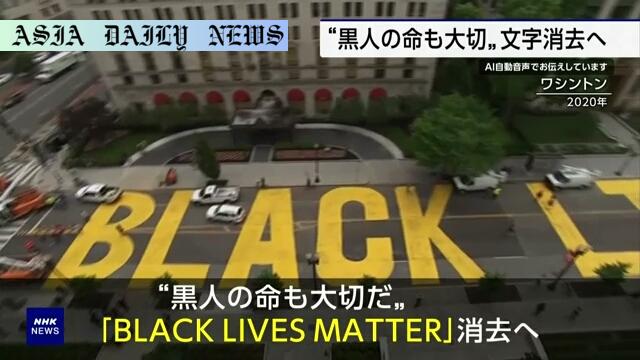Black Lives Matter Mural: Washington DC workers begin removing the iconic street art, sparking debates on racism and public art.
- Black Lives Matter Mural was created during 2020 protests.
- Washington Mayor Muriel Bowser ordered its removal.
- A Republican congressman introduced a bill leading to its erasure.
- The mural’s removal has reignited debates on racism and public expression.

Introduction
The Black Lives Matter mural, a poignant symbol of 2020’s nationwide protests against racism, is being removed by workers in Washington DC. Situated near the White House, the two-block-long painting served as both a statement against systemic racism and a focal point for advocacy against police brutality, especially following the tragic death of George Floyd. However, this decision has sparked widespread debate, reflecting ongoing tensions over how the US addresses its legacy of race relations and free expression.
The Origins of the Black Lives Matter Mural
In 2020, protests erupted nationwide after George Floyd, an unarmed Black man, was killed by a white police officer in Minneapolis. Amid the unrest, demonstrators expressed their anger through marches, speeches, and art, with the Black Lives Matter mural becoming an iconic symbol. Painted directly onto a Washington DC street, this mural boldly declared solidarity with those fighting racial injustice. Its proximity to the White House made it particularly significant, symbolizing resistance against policies perceived as dismissive of systemic racism.
The Debate and Political Pressure
Recently, under growing pressure from Republican lawmakers, the Washington DC Mayor, Muriel Bowser, decided to remove the mural. Critics, including Republican congressman Andrew Clyde, introduced a bill proposing a freeze on federal funding to DC if the artwork was allowed to remain, arguing it carried partisan undertones. This has drawn considerable backlash from activists who feel the mural’s erasure undermines progress toward racial equality.
Mural’s Removal Reflects Ongoing Struggles
The decision highlights the challenges of navigating race-related issues in American politics. Proponents of the mural’s removal argue it was unnecessarily provocative, particularly toward law enforcement. Opponents, however, view this as a rejection of the progress made in addressing systemic racism. These conflicting perspectives demonstrate the complexity of balancing public art, activism, and political pressure in society today.
Conclusion
The removal of the Black Lives Matter mural signifies more than a change to a city street; it reflects a broader societal struggle about how to address historical injustices and their lasting impact. As the mural fades, so does its role as a visual reminder of protest and solidarity. Yet, the conversations it has provoked will likely persist, sparking further dialogue about free expression, racial justice, and the role of public symbols in shaping national identity.



Commentary
The Symbolic Nature of Public Art
Public artworks, such as the Black Lives Matter mural, serve a critical role in sparking conversations and reflecting societal values. In 2020, this painting became more than art—it became a bold proclamation for change, echoing the sentiments of millions who demanded accountability and justice. Its removal stirs a debate not just on politics but also on the power of symbols and messages in unifying or dividing communities.
Racial Justice and Political Motives
The removal of the mural reflects deep-seated tensions in America’s political landscape. While some argue that public funds should not endorse partisan messages, it’s essential to recognize that the mural arose from a grassroots movement rather than a political campaign. Erasing such a symbol might feel to some like erasing the memory of the injustices it sought to address. The political motivations backing this decision highlight an ongoing struggle over how the US should commemorate or confront its history of racial inequality.
A Call for Further Dialogue
While the physical mural may disappear, its message cannot be so easily erased. The mural’s removal offers an opportunity to reignite discussions around systemic racism, accountability, and equity. Such dialogues must go beyond partisan disputes and focus on fostering understanding and actionable solutions. Public art is merely one medium, but the conversations they spark are what carry potential for lasting change.